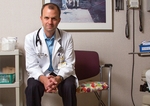Opinion
Patient safety: A leadership opportunity
■ The AMA has published tool kits designed to encourage doctors to get involved in the 100,000 Lives Campaign.
Posted Nov. 14, 2005.
- WITH THIS STORY:
- » External links
When it comes to improving patient safety, who better to take up the charge than physicians? Their relationships with patients, hospitals and their communities make them naturals.
But how does one go about tackling such an enormous undertaking? Certainly not alone and not without guidance.
Fortunately for physicians interested in getting involved, a program already exists that they can jump into. The initiative, called the 100,000 Lives Campaign, encourages hospitals to apply six evidence-based interventions. The goal is to prevent 100,000 avoidable deaths in hospitals over the course of 18 months, ending in June 2006, and maintain this progress each year thereafter.
The interventions are to deploy rapid response teams that quickly address early signs of patient distress; to ensure the best care for people with acute myocardial infarction; and to prevent surgical site infections, ventilator-associated pneumonia, central line infections and adverse drug events.
So far, more than 2,800 hospitals are involved in the effort -- well more than the 2,000 originally hoped for -- that started in December 2004. But such initiatives cannot succeed without physician participation. That's where the American Medical Association comes in.
The AMA is a strategic partner in the initiative, launched by the Institute for Healthcare Improvement. In this role, the AMA is spreading the word to physicians through its Making Strides in Safety program.
The Association's latest action is to publish two online tool kits to encourage physicians to join the initiative. Both explain the campaign, highlight why physician participation is so important and offer practical advice doctors can take to get started.
At the hundreds of hospitals engaged in the effort, physicians now have a concrete way to get involved in a formal patient safety program if they haven't already done so. At those institutions that haven't joined, the first step for doctors is to convince the hospital leadership to sign on.
The two AMA documents stress the need for teamwork. No physician can handle this task alone. It takes support and help from the hospital administration, medical staff and executive committees, and other personnel. Communication and education are key.
The benefit to patients is clear -- better care and safer hospitals. But, as the AMA materials point out, there are pluses for physicians, too. The 100,000 Lives Campaign gives doctors a unique opportunity for personal satisfaction by going beyond their normal practice and helping to improve patient health in their communities and nationally. It also promotes the science of medicine and shows that physicians are leaders in the hospital setting.
The tool kits are only part of the AMA's most recent efforts to help doctors get involved in formal patient safety efforts. In September and October, the Association co-sponsored with Joint Commission Resources a conference, "Moving from the Sidelines to the Frontlines of Patient Safety: Empowering the Medical Staff." The meetings gave doctors a chance to learn different strategies that support a culture of patient safety both in the hospital and practice setting.
These activities come on the heels of the passage in July of the Patient Safety and Quality Improvement Act.
This law, supported by the AMA, establishes a confidential and voluntary system for reporting medical errors.
With a federal system approved, the focus now falls on local patient safety efforts. Physician leadership is essential, and the 100,000 Lives Campaign provides an excellent opportunity.
The tool kit says it best: "You are the guardians of safety -- for society, your community and your patients."












